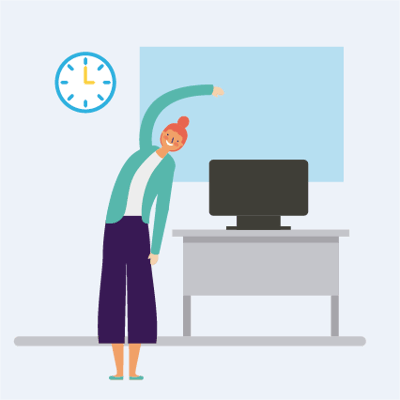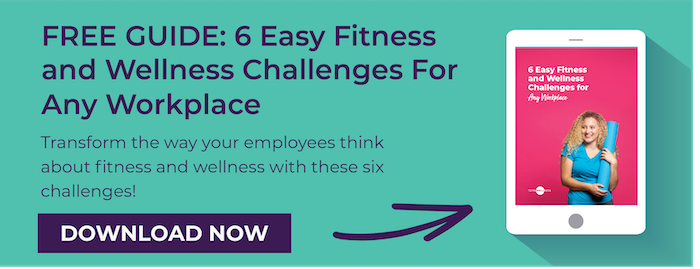 As many of us find ourselves working from home (and sitting for longer periods), it’s more important than ever to make time to move our bodies.
As many of us find ourselves working from home (and sitting for longer periods), it’s more important than ever to make time to move our bodies.
Even if it’s not a full-fledged workout routine, you can still fit movement into your daily work schedule. And if you’ve ever wondered: “Is stretching exercise?”, the answer is yes — it’s actually an essential part of standalone bodywork and exercise routines.
Stretching benefits your posture, balance, mobility, and much more.
Many people overlook the importance of stretching for overall physical health. The fact is, remaining flexible can help reduce injuries and provide an overall feeling of well-being.
Here we dig into stretching benefits and easy stretches you can do anywhere.
The 4 Types of Exercise
While some of us like to stick to what we’re comfortable with for exercise, it’s actually best to incorporate multiple aspects of exercise. All four components are important to stay healthy.
Here’s a look at the four exercise types:
Endurance - These are aerobic activities that get your heart rate going. These are necessary to keep the heart muscles strong, reduce inflammation, and boost mood. Additionally, it can lower “bad” LDL cholesterol, too, if paired with weight loss.
Examples of endurance:
- Marching in place
- Jumping rope
- Jumping jacks
- Running
- Cycling
Strength - The older we get, the weaker our muscles get. Resistance or strength training to build muscle can help you maintain your ability to live independently. Tasks that seem simple — like getting out of a chair or going up stairs — can be challenging for those without strength.
Examples of strength training:
- Squats
- Lunges
- Push-ups
- Pull-ups
- Planks
- Free weights
Balance - Keeping up with your balance efforts can help prevent falls as you age. Balance is a skill we don’t think about until it becomes a problem. Walking and going up staircases both require good balance.
Examples of balance exercises:
- Yoga
- Tai chi
- Yoga ball workouts
Flexibility - When you work on flexibility daily, you keep muscles and joints limber. This is done with stretching, which can also minimize joint pains and falling. When you stretch your body, it makes the muscles longer and improves range of motion.
Examples of stretching activities:
- Yoga
- Toe touches
- 90/90 stretch
- Triceps stretch
- Butterfly stretch
As you can imagine, some activities may fall into multiple categories above. Dancing, for example, could be considered as endurance, strength, and balance. And most dance workouts recommend stretching before moving into routines.
Types of Stretching
There are many types of stretching and stretching techniques, but the two main categories are dynamic and static. For static stretching, these are slower movements that isolate one muscle group at a time. Consider dynamic stretching as an energetic and active way to perform stretches.
A look at the difference:
- Static - This means you hold the stretch to the extent of your ability for a certain amount of time, usually 15-30 seconds. This includes stretches like holding your knee to your chest, tilting your neck to the side, etc. The American College of Sports Medicine recommends to repeat each static exercise no more than four times.
- Dynamic - These include active movements that move the muscles and joints through a full range of motion. Arm circles, for example, would fall into this category.
The Biggest Stretching Benefits
If you’ve done any stretching in the past, you know it can be time-consuming and sometimes even uncomfortable.
But prior to working out, it’s important to warm up the muscles in some fashion. This creates a better range of motion for your activities and reduces the risk of injury. That’s where the static and dynamic stretching comes into play.
Not surprisingly, exercise and stretching routines like yoga and tai chi can lead to a feeling of overall well being as well. It helps you focus on the stretch in the moment and can ease stress.
Additional stretching benefits include:
- Increased mobility
- Better posture
- Protects against injuries
- Better balance
- Increases blood flow
- Can help fight drowsiness
When your muscles aren’t tight, they don’t overcompensate and make you feel “out of whack” as some may describe it. You’ll be able to move freely when your muscles are loose — especially if you’re getting ready to exercise.
When to Stretch Your Body
The American College of Sports Medicine recommends that adults incorporate stretching each of the major muscle groups at least two times a week for 60 seconds per exercise. There’s never a really bad time to stretch.
So, when should you stretch?
- After sitting too long
- When feeling fatigued
- Static stretches are better after exercise
- Dynamic stretches are better before exercise to help you “warm up”
Unless you have hypermobility — where joints move beyond normal ranges of motion — it’s safe for most individuals to engage in stretching. In the case you do have hypermobility, you should work with a physical therapist to determine which exercises and stretches would be safest for you.
Simple Stretches You Can Do at Your Desk
Discomfort from sitting too much? Do simple stretches every hour or so to keep muscles from getting too stiff. Here are a few examples of stretches you can do whether you're in your home office or work office.
Standing Cat-Camel
- Stand with feet shoulder-width apart and knees slightly bent
- Lean forward to place your hands just above your knees
- Alternate rounding and arching your back (curve the shoulders forward and back at the same time)
- Repeat
Standing Toe Touch
- Stand and keep legs straight but knees unlocked
- Bend from the hips and reach for your toes
- Hold for several seconds
- Straighten
- Repeat
Seated Spine Twist
- Sit on the ground and place legs directly in front of you
- Bend your right knee and place right foot on outside of left thigh
- Keep left leg straight
- Place left elbow on outside of right knee
- Reach your right hand behind you and look over right shoulder
- Switch legs and repeat other side
- Do both sides several times
Arm Hugs
- Cross one arm over the body to touch the opposite shoulder
- Use the other arm to deepen the stretch
- Reverse and repeat
Side Stretch
- Sitting or standing, reach both arms straight up, grab the left wrist with the right hand
- Lean up and out to the right, pulling gently on the left wrist
- Reverse and repeat
Sitting Hamstring Stretch
- Straighten your legs
- Fold your body towards your toes while keeping your back straight
- Count to 10 or 15
- Slowly roll back up
- Repeat
Stretching is a Good Activity for Most
When you get into a regular routine, you’ll find the stretching benefits are plentiful. Both newbies and seasoned gym rats can benefit from regular stretching. Even if you spend five or ten minutes stretching in general or prior to a workout, you’ll quickly see how helpful it can be.
Additionally, it’s important to note that stretching may not be for everybody. Like most things in life, there are some exceptions to the rule.
Reconsider it if you:
- Have a chronic injury
- Are dealing with a current injury
- Were diagnosed with hypermobile joints
- Have physical limitations that may prevent proper stretching
Beyond those issues, most individuals find it’s a great way to promote circulation, improve muscular efficiency, and reduce the risk of injury.
Here’s to stretching yourself into health and relaxation!
Want to help your employees take a health or fitness challenge to the next level? Try our 6 Easy Fitness and Wellness Challenges For Any Workplace.
Image credit: Computer vector created by gstudioimagen



